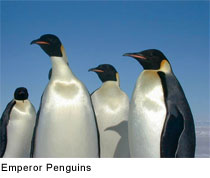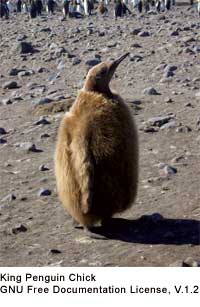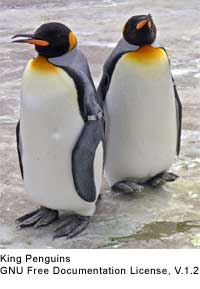|

 Weights and Measures: The largest species is the Emperor Penguin (Aptenodytes forsteri): adults average about 1.1 m (3 ft 7 in) tall and weigh 35 kg (75 lb) or more. The smallest penguin species is Weights and Measures: The largest species is the Emperor Penguin (Aptenodytes forsteri): adults average about 1.1 m (3 ft 7 in) tall and weigh 35 kg (75 lb) or more. The smallest penguin species is
the Little Blue Penguin (also known as the Fairy Penguin), which stands around 40 cm tall (16 in) and weighs 1 kg (2.2 lb). Generally larger penguins retain heat better, and thus inhabit colder regions, while smaller penguins are found in temperate or even tropical climates.

Hot and Cold: Although all penguin species are native to the southern hemisphere, they are not, contrary to popular belief, found only in cold climates, such as Antarctica. In fact, only a few species of penguin actually live so far south. Three species live in the tropics; one lives as far north as the Galápagos Islands (the Galápagos Penguin) and will occasionally cross the equator while feeding.
 Penguin Prey: Most penguins feed on krill, fish, squid, and other forms of sea life Penguin Prey: Most penguins feed on krill, fish, squid, and other forms of sea life
caught while swimming underwater. They
spend half of their life on land and half in the oceans.
Kidnappers: When mothers lose a chick, they sometimes attempt to steal another mother's chick, usually unsuccessfully as other females in the vicinity assist the defending mother in keeping her chick.
Fearless and Feathered: Penguins seem to have no fear of humans, and have approached groups of explorers without hesitation.

Brave Breeders: Emperor Penguins (the largest penguins) first begin to breed at approximately five years of age. Emperor penguins travel about 90 km inland to reach the breeding site. In March or April, the penguins start courtship, when the temperature can be as low as -40 degrees C (-40°F).
Annual Attachment: Emperor penguins are serially monogamous. They have only one mate each year, and keep faithfully to that one other penguin, but each year, most choose different mates.
 Penguin Parenting:
In May or June, the female penguin lays one 450-gram (1 pound) egg, but at this point her nutritional reserves are exhausted and she must immediately return to the sea to feed. Very carefully, she transfers the egg to the male penguin, who will incubate the egg in his brood pouch for Penguin Parenting:
In May or June, the female penguin lays one 450-gram (1 pound) egg, but at this point her nutritional reserves are exhausted and she must immediately return to the sea to feed. Very carefully, she transfers the egg to the male penguin, who will incubate the egg in his brood pouch for
about 65 days consecutively without food by surviving on his fat reserves and spending
the majority of the time sleeping to
conserve energy.
To survive the cold and wind (up to 200 km
per hour, or 120 mph), the males huddle
together, taking turns in the middle of the huddle.
If the chick hatches before the mother's return, the father sits the chick on his feet and
covers it with his pouch, feeding it a white milky substance produced by a gland in
his esophagus.
After about two months, the female returns. She finds her mate among the hundreds of fathers via his call and takes over caring for the chick, feeding it by regurgitating the food that she has stored in her stomach. The male then leaves to take his turn at sea. After another few weeks, the male returns and both parents tend to the chick by keeping it off the ice and feeding it food from their stomachs. About two months after the egg hatches, as the weather becomes milder, the chicks huddle in a crèche for warmth and protection, still fed by their parents using the food from their stomachs.

Species Speculation: The number of extant species has been and still is a matter of debate. The numbers of penguin species listed in the literature vary between 16 and 19 species. Some sources consider the White-Flippered Penguin a separate Eudyptula species, although today it is generally considered a subspecies of the Little Penguin (e.g. Williams, 1995; Davis & Renner, 2003). Similarly, it is still unclear whether the  Royal Penguin is merely a colour morph of the Macaroni penguin. Also possibly eligible to be treated as a separate species is the Northern population of Rockhopper penguins (Davis & Renner, 2003). Royal Penguin is merely a colour morph of the Macaroni penguin. Also possibly eligible to be treated as a separate species is the Northern population of Rockhopper penguins (Davis & Renner, 2003).
Penguin Evolution: The evolutionary history of penguins is poorly understood, as penguin fossils are rare. The oldest known fossil penguin species are the Waimanu, which lived in the early Paleocene epoch of New Zealand, about 62 million years ago. While they were not as well adapted to aquatic life as modern penguins (which first emerged in the Eocene epoch 40 million years ago), Waimanu were flightless and loon-like, with short wings adapted for deep diving.
These fossils prove that prehistoric penguins were already flightless and seagoing, so their origins probably reach as far back as 65 million years ago, before the extinction of the dinosaurs. Penguin ancestry beyond Waimanu is not well known, though some scientists (Mayr, 2005) think the penguin-like plotopterids (usually considered relatives of anhingas and cormorants) may actually be an early sister group of the penguins, and that penguins may have ultimately shared a common ancestor with the Pelecaniformes.
All text is available under the terms
of the GNU Free Documentation License
|